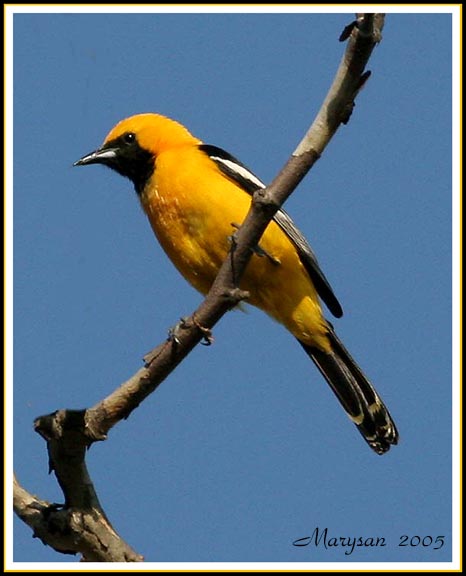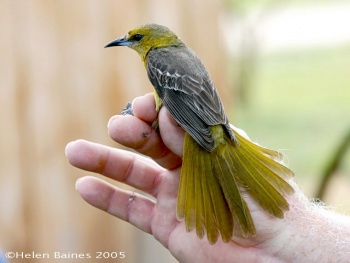
Photo © by Marysan
at Mission Trails Regional Park, San Diego, California, 2 May 2005
- Icterus cucullatus
Identification

Photo © by Helen Baines
At a banding station, Concan, Texas Hill Country, 28 April 2005
18-20 cm (7-8 in),
- Long graduated tail
- Long, thin, downward curved bill
Breeding male
- Orange-yellow head and nape
- Black back, face, throat, and upper breast
- Black wings have two white bars
- Black tail
Female
- Olive-grey upperparts
- Yellow-green underparts, mostly with grey flanks
- Upper wing bar stronger than lower
Juvenile: similar to female; male may show black on throat
Geographic variation
Western birds are generally shorter tailed, and males have less orange on heads and body. Flank color in females varies but not necessarily with an east-west division.
Similar Species
On males notice the black facial mask goes down perpedicular to the line from eye to upper bill, so that the black area constitutes a square. Similar, black-faced, species have an angle smaller than 90 deg.
Females can be quite similar to female Orchard Oriole, which is smaller, have square tail, shorter stouter bill with almost straight culmen, usually brighter green on upperside and brighter, more evenly colored underside including the flanks.
Distribution
Breeds from central California, Nevada, central Arizona, southern New Mexico, and southern Texas southward through Mexico to Belize. Some of the Mexican breeders seems to have bred already in the same summer in the US before migrating to Mexico for their second round of nesting.
A few spend winters in southern California and southern Texas, most of the rest winter in Mexico.
Casual vagrant to Oregon and Washington. Accidental vagrant to Ontario, Quebec, and Louisiana.
Taxonomy
Subspecies
Currently, six subspecies are recognized by Clements[1], with several others considered synonyms[2]:
Eastern Group
- I. c. sennetti:
- I. c. cucullatus:
- South-western Texas (Del Rio) to south-eastern Mexico (Veracruz and Oaxaca)
- South-western Texas (Del Rio) to south-eastern Mexico (Veracruz and Oaxaca)
Western Group
- I. c. nelsoni:
- Central California to northern Baja and north-western Mexico (southern Sonora, northern Chihuahua)
- I. c. trochiloides:
- Southern Baja California (latitude 27oN to Cabo San Lucas)
- I. c. restrictus:
- North-western Mexico (southern Sonora)
- I. c. igneus (Yucatan):
- Yucatan Peninsula, Cozumel, Contoy, Holbox and Mujeres Island to Belize
Habitat
Usually found in scrubby or open woods, desert, urban gardens and forests. Observed at heights around 5000 feet.
Behaviour
Breeding
They nest in tall trees, often in fan palms, cottonwoods, sycamores, oaks, and eucalyptus. The cup-shaped nest is made by the female and suspended from branches. The 3-5 white, pale yellow or pale blue eggs are incubated for about 12-14 days, by the female.
Their nests in California become parasitized by both the Bronzed Cowbird and Brown-headed Cowbird.
Diet
Diet includes fruit, nectar, and insects.
Vocalisation
Described as variable but not necessarily loud or striking.
Song is a rapid, variable warble.
Calls include a dry chatter, chek and tchek sounds, etc.
Gallery
Click on image to enlarge
Western pair arguing
Photo © by tehag
Nopoló, Baja California Sur, 28 May 2008Photo © by digishooter
Wofford Heights, California, USA, 18 May 2018
References
- Clements, J. F., T. S. Schulenberg, M. J. Iliff, S. M. Billerman, T. A. Fredericks, B. L. Sullivan, and C. L. Wood. 2019. The eBird/Clements Checklist of Birds of the World: v2019. Downloaded from http://www.birds.cornell.edu/clementschecklist/download/
- Lepage D. (2020) Hooded_Oriole in Avibase - The World Bird Database. Retrieved 15April 2020
- Sievert Rohwer, Keith A. Hobson, Vanya G. Rohwer (2009) Migratory double breeding in Neotropical migrant birds. Proceedings of the National Academy of Sciences. https://doi.org/10.1073/pnas.0908121106
- Howell, SNG and S Webb. 1995. A Guide to the Birds of Mexico and Northern Central America. New York: Oxford Univ. Press. ISBN 978-0198540120
- Pleasants, B. Y. and D. J. Albano (2020). Hooded Oriole (Icterus cucullatus), version 1.0. In Birds of the World (A. F. Poole and F. B. Gill, Editors). Cornell Lab of Ornithology, Ithaca, NY, USA. https://doi.org/10.2173/bow.hooori.01
Recommended Citation
- BirdForum Opus contributors. (2025) Hooded Oriole. In: BirdForum, the forum for wild birds and birding. Retrieved 11 May 2025 from https://www.birdforum.net/opus/Hooded_Oriole
External Links
Search the Gallery for Hooded Oriole videos:
GSearch checked for 2020 platform.1









